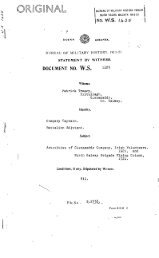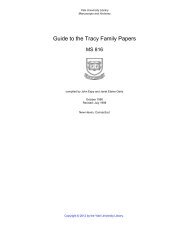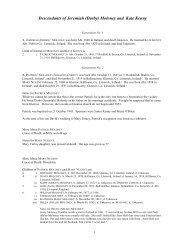The Carrickshock Incident, 1831: Social Memory and an Irish cause ...
The Carrickshock Incident, 1831: Social Memory and an Irish cause ...
The Carrickshock Incident, 1831: Social Memory and an Irish cause ...
Create successful ePaper yourself
Turn your PDF publications into a flip-book with our unique Google optimized e-Paper software.
<strong>The</strong> <strong>Carrickshock</strong> <strong>Incident</strong>, <strong>1831</strong> 49<br />
in the narrow de le of <strong>Carrickshock</strong>’. 51 <strong>The</strong> very notion of chapel bells<br />
calling Catholics out to slaughter policemen was repellent enough to<br />
m<strong>an</strong>y Protest<strong>an</strong>ts; even worse was the suspicion that local priests had<br />
orchestrated the affair. 52<br />
More th<strong>an</strong> 30 years later, the English writer Henry Addison included<br />
<strong>an</strong> entire chapter on <strong>Carrickshock</strong> in his semi- ctional memoir of police<br />
work in pre-famine Irel<strong><strong>an</strong>d</strong> that epitomized <strong>an</strong>ti-nationalist sentiment.<br />
In his judgement, the murder of the 13 constables <strong><strong>an</strong>d</strong> process<br />
server was nothing less th<strong>an</strong> ‘the most savage butchery that ever disgraced<br />
the <strong>an</strong>nals of Irel<strong><strong>an</strong>d</strong>’. 53 His breathtakingly inaccurate description<br />
of the ght, though brief, repeated certain motifs that other tory<br />
writers had developed over the previous decades. <strong>The</strong>se included the<br />
assertion that Gibbons <strong><strong>an</strong>d</strong> his men were lured into a carefully laid<br />
trap, a claim that persisted into the late twentieth century. 54 Addison<br />
also elaborated upon the common loyalist assertion that the crowd<br />
behaved with particular callousness toward their victims. <strong>The</strong> corpses<br />
of the dead policemen, he wrote, ‘were pierced with innumerable<br />
wounds. <strong>The</strong>[ir] arms were seized with avidity <strong><strong>an</strong>d</strong> then the murderers<br />
% marched off glorying in the act <strong><strong>an</strong>d</strong> even singing songs of delight’. 55<br />
<strong>The</strong> remainder of Addison’s 1862 narrative (curiously subtitled ‘A<br />
Pleas<strong>an</strong>t Excursion’) is <strong>an</strong> improbable description of his adventures in<br />
<strong><strong>an</strong>d</strong> around <strong>Carrickshock</strong> a few days after the incident, in the comp<strong>an</strong>y<br />
of a r<strong>an</strong>king constabulary of cer. Addison tells how the two men somehow<br />
discovered by moonlight a severed nger <strong><strong>an</strong>d</strong> a piece of hum<strong>an</strong><br />
skull on the site of the killings, after which they barely escaped with<br />
their lives from a drunken mob who were celebrating the acquittals of<br />
the men who murdered the policemen. Related in the lurid style of<br />
a penny-dreadful thriller, their supposed escapades underscored the<br />
savagery that <strong>Carrickshock</strong> had come to represent in the perceptions<br />
of <strong>an</strong>ti-nationalists. 56<br />
If loyalists remembered <strong>Carrickshock</strong> in such unequivocal terms,<br />
most nationalists from outside the locality saw it as a problematic site<br />
of memory. Unlike local people who, as we have seen, took unambiguous<br />
pride in the incident be<strong>cause</strong> it represented the destruction of<br />
their persecutors, middle-class nationalists from Dublin <strong><strong>an</strong>d</strong> elsewhere<br />
were decidedly ambivalent. D<strong>an</strong>iel O’Connell spoke for m<strong>an</strong>y when he<br />
51 Michael Crotty, <strong>The</strong> Catholic, Not the Rom<strong>an</strong> Catholic, Church, Exhibited in Letters of the<br />
Reverend Messieurs Michael <strong><strong>an</strong>d</strong> William Crotty, Catholic Priests of Parsonstown (D.R.<br />
Bleakley, Dublin, 1836) p. 36.<br />
52 See, for example, Dublin Evening Mail, 20 Dec <strong>1831</strong>.<br />
53 Henry R. Addison, Recollections of <strong>an</strong> <strong>Irish</strong> Police Magistrate <strong><strong>an</strong>d</strong> Other Reminiscences of the<br />
South of Irel<strong><strong>an</strong>d</strong> (Ward <strong><strong>an</strong>d</strong> Lock, London, 1862) p. 29.<br />
54 See, for example, Edward Garner, Massacre at Rathcormac: Last Battle in the Tithe War<br />
(Éigse, Fermoy, 1984) p. 13; R.H. Curtis, <strong>The</strong> History of the Royal <strong>Irish</strong> Constabulary<br />
(Moffat, Dublin, 1869) pp. 31–2.<br />
55 Addison, Recollections, p. 35.<br />
56 On Addison’s views of Irel<strong><strong>an</strong>d</strong> <strong><strong>an</strong>d</strong> the <strong>Irish</strong>, see Virginia Crossm<strong>an</strong>, ‘<strong>The</strong> Resident<br />
Magistrate as Colonial Of cer: Addison, Somerville <strong><strong>an</strong>d</strong> Ross’, <strong>Irish</strong> Studies Review, 8,<br />
1 (2000) pp. 23–33.<br />
Cultural <strong><strong>an</strong>d</strong> <strong>Social</strong> History 2004 1 (1)
















